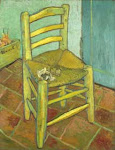I've been 'into' Greek mythology for about thirty years now (gasp! I'm old!), and I have to say, I never liked Helen of Troy much. She always struck me as the kind of person I would not like being around, and she always struck me as being enormously selfish. But reading Margaret George's "Helen of Troy" this summer has given me a different perspective into this character, and for that I have to thank Ms. George and her terrific storytelling. I hadn't read "Helen of Troy" before now because I feared it would annoy me as much as the movie "Troy" had done -- but Ms. George's keynote speech at the Historical Novel Society conference convinced me to give it a whirl. I'm glad I did!
Ms. George had a lot to contend with in crafting this story. The Iliad only covers one small part of the Trojan War saga; there are many other tales woven into the mythological tradition, and unfortunately, we know about several epic poems that no longer exist. Ms. George admirably brings together all the threads of the story: she even brings in the Amazons (readers may think she made up the Amazons coming to Troy for her novel, but she did not--a now-lost epic poem called the Aithiopis detailed this episode). At the same time, she introduces enough of her own flourishes to create a cohesive tale and flesh out the narrative. The Bronze Age isn't my academic specialty, but I've read enough of the scholarship to recognize that Ms. George has read it too. She captures the spirit of the times and introduces some of the latest archaeological findings while avoiding the dreaded 'research dump.' Those who are familiar with the mythological tradition will find plenty of places to smile, appreciating the way Ms. George deftly incorporates this or that detail.
Ms. George's Helen is a complex character. The novel is told in first person, which allows the reader to engage closely with Helen and understand her choices a bit more (even if the reader does not agree with them). For Helen, her beauty is a curse, and while there is a bit of "don't hate me because I'm beautiful" here, it works with the story. The scenes of the Ilioupersis (Fall of Troy) are particularly moving.
The one quibble I have concerns Achilles. True, in the Iliad Achilles acts like an arrogant jerk, but in Ms. George's novel he is the one character who is basically two-dimensional. Also true that Helen does not have an opportunity to 'get to know' Achilles, but Ms. George changed something that troubled me, the only time in reading the entire book that I went "nooooo!" In the Iliad the so-called Ransom of Hektor scene, when king Priam visits Achilles in his tent to retrieve his son's body, is the turning point of the entire poem. It is Achilles' redemption. (In fact, it's the only episode that the movie "Troy" got close to right.) But Ms. George adds a 'postscript' of sorts to that scene -- something Achilles demands of the Trojans the morning after -- that is not in the Iliad. And I have to say, that 'postscript' spoils the character of Achilles as we know it from the Homeric tradition. Most readers might not notice or care, but it disappointed me. For all Achilles' faults, I love that guy!
That one quibble aside, I loved this book, and I recommend it to anyone who enjoys Greek myth and seeks a retelling that is faithful to the spirit of the original stories.







